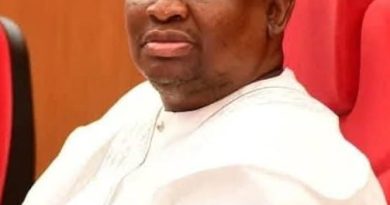Bisi Onabanjo on My Mind
For those of us who had our secondary education in Ogun State between 1978 and 1983, late Chief Victor Olabisi Onabanjo remains a folklore hero. The man became the first elected governor of a young state which was just 44 months old in October 1979 and realized that his victory at the polls was as a result of popular support for his party, the Unity Party of Nigeria (UPN).
One of the cardinal programmes of his party was free education. While there are many enduring landmark edifices built by the Onabanjo administration in its four years, three months tenure, as a direct beneficiary, the education programme is still the area where one continues to have the most appreciation of the ingenuity of Chief Obafemi Awolowo and his lieutenants. In a place like Ogun State where education was and remains a major industry as the people have by then had close to two century exposure to Western education, the UPN captured the heart of the people with its creative investment in establishment of new schools, building of new education infrastructure, supply of free textbooks, notebooks and other instructional materials, while tuition fees were abolished in secondary schools.
The quality of teaching in Ogun state was so high that some of my mates were from Lagos, Oyo and places that are now in Edo and Osun States. People from neighbouring states came to get good education in Ogun State and benefit from the free education policy. Incidentally, when I returned to live in Ogun State in 2011, I found that one area where the erosion and compromise of the Onabanjo legacy was more evident is in the area of education. Over the years, schools in Ogun State had suffered serious neglect. The infrastructure had collapsed. Quality of teaching had become prostrate. Teachers were disenchanted and teaching had become a second profession to them. As a result of these negative developments, students themselves have become disoriented.
These are the challenges that the present administration in Ogun State headed by Senator Ibikunle Amosun had to contend with since its inception on May 29, 2011. Incidentally, the first item in the administration’s Mission to Rebuild Agenda is Affordable Qualitative Education.
With its meager resources, the present government, like that of Onabanjo, abolished tuition fees in all its 1,491 primary and 473 secondary schools. Also, an audit of number of pupils and students in public schools were taken and textbooks, notebooks and instructional materials were supplied to each of them as we enjoyed under the Onabanjo administration. The Amosun administration also initiated a programme in which it gradually began the renovation and reconstruction of blocks of classrooms in the schools as well as supply of new furniture in those schools. To enable it pay for the cost of these infrastructural facilities, the government entered into negotiation with the Universal Basic Education (UBE) and Education Trust Fund (ETF), in which it paid the backlog of its counterpart fund dating back to 2008 so that it can access the fund due to the state which had been lying fallow.
That is why one would see new buildings and furniture in some primary and secondary schools with the inscription ‘SUBEB 2008/ 2009’, yet they were built by the current administration with the money accessed in arrears from UBE for the year inscribed on them as directed by the relevant federal intervention agency. However, with the extent of rot inherited by the present administration in the area of infrastructure, it is not uncommon to still see some school buildings that are not in good shape. Definitely, renovation and reconstruction of classroom buildings is a work-in-progress that will take a few more years before normalcy can be totally restored.
As it was in the Onabanjo era when new schools were built to accommodate the growing number of students, the Amosun administration is on the verge of completing 15 model secondary schools with each of them having a carrying capacity of 1,000 students. The model schools are being constructed in preparation for the return of schools originally owned by missionaries.
Again, government has introduced the unified examinations in primary and secondary schools in which all pupils and students write the same examinations, centrally administered and paid for by the government. The implication is that tutors are forced to cover their syllabus, the quality of teaching automatically improves and level of performance of students in internal and external examinations continues to grow higher. In any case, government has religiously paid the WAEC fees of final year secondary school students while those in technical schools enjoy the same privilege.
The students are further motivated by the reward of a foreign leadership training that the foundation run by wife of the governor, Mrs. Olufunso Amosun, gives to the 20 students with best WAEC results selected from the 20 Local Government Areas. These progressive policies explain why enrolment in Junior Secondary Schools has jumped from 174,820 in 2011 to 214,837 while that of the Senior Secondary Schools has moved from 146, 737 to 162,536 in the last three years. The performance in WAEC has also improved by over 100 percent from what it used to be in 2011. Similarly, the Higher Education Performance (HEP) rate has moved from 18 percent in 2011/12 to 49.8 percent in 2012/13.
Today, teachers in the state have never had a better deal. Schools now get money for running cost. They get 27.5 percent Peculiar Allowance and 13th month salary allowance. They are due to get the recently approved car and housing loans of between N500, 000 to N2 million and N1 million to N5 million respectively, depending on the salary scale. The loan will enable some of them to purchase comfortable apartment flats in the AAK Degun MTR Estate, Laderin in Abeokuta, specifically built by the government for public servants. Since 2011, Ogun State’s teachers have been participating in different all-year round training programmes aimed at improving their competence. No wonder, Ogun State has been carting away majority of the awards in the National Teachers Awards being given by the Federal Government. The state government also gives similar award to further motivate the teachers.
The seven tertiary schools owned by the state are not left behind. They get improved monthly subvention paid regularly to enable the school authorities meet their financial demands. The government has introduced policies aimed at overhauling the system. Infrastructural, education and transport facilities aimed at repositioning the schools and returning them to the prime position they occupied in the immediate years following the exit of the Onabanjo era.
Despite the propaganda by some opposition elements, I make bold to say the state government has not approved any request for increment in school fees in these higher institutions since 2011. Rather, since 2011, it has directed an across-the-board reduction in fees while also insisting on operation of a cashless policy aimed at institutionalizing financial discipline in the school.
It is for the above reasons that each time one reviews the developments in the Ogun State education sector, one is tempted to conclude that there is a re-enactment of Onabanjo’s golden years.
Olaniyonu is the Commissioner for Information and Strategy, Ogun State





